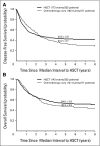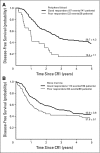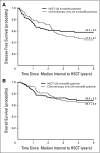Clinical outcome of children with newly diagnosed Philadelphia chromosome-positive acute lymphoblastic leukemia treated between 1995 and 2005
- PMID: 20876426
- PMCID: PMC3020705
- DOI: 10.1200/JCO.2010.30.1325
Clinical outcome of children with newly diagnosed Philadelphia chromosome-positive acute lymphoblastic leukemia treated between 1995 and 2005
Abstract
Purpose: In a previous analysis of 326 children with Philadelphia chromosome (Ph) -positive acute lymphoblastic leukemia (ALL) treated between 1986 and 1996, hematopoietic stem-cell transplantation from HLA-matched related donors, but not from unrelated donors, offered a superior outcome than chemotherapy alone. To evaluate the impact of recent improvements in chemotherapy and transplantation, we performed a similar analysis on patients treated in the following decade.
Patients and methods: We analyzed 610 patients with Ph-positive ALL treated between 1995 and 2005 without tyrosine kinase inhibitor therapy. The median follow-up duration was 6.3 years.
Results: Complete remission was achieved in 89% of patients. The 7-year event-free survival and overall survival rates were superior in the present cohort compared with the previous cohort (32.0% ± 2.0% v 25.0% ± 3.0, respectively, P = .007; and 44.9% ± 2.2% v 36.0% ± 3.0%, respectively, P = .017). Compared with chemotherapy alone, transplantation with matched related donors or unrelated donors in first remission (325 patients) showed an advantage with increasing follow-up, suggesting greater protection against late relapses (hazard ratio at 5 years, 0.37; P < .001). In the multivariate Cox regression analysis accounting for treatment (transplantation v no transplantation), age, leukocyte count, and early response had independent impact on treatment outcome.
Conclusion: Clinical outcome of children and adolescents with Ph-positive ALL has improved with advances in transplantation and chemotherapy. Transplantations with matched related donors and unrelated donors were equivalent and offered better disease control compared with chemotherapy alone. Age, leukocyte count, and early treatment response were independent prognostic indicators. The results of this study will serve as a historical reference to evaluate the therapeutic impact of tyrosine kinase inhibitors on the outcome of Ph-positive ALL.
Conflict of interest statement
Authors' disclosures of potential conflicts of interest and author contributions are found at the end of this article.
Figures





References
-
- %Schrappe M, Nachman J, Hunger S, et al. Educational symposium on long-term results of large prospective clinical trials for childhood acute lymphoblastic leukemia (1985–2000) Leukemia. 2010;24:253–254. - PubMed
-
- Schlieben S, Borkhardt A, Reinisch I, et al. Incidence and clinical outcome of children with BCR/ABL-positive acute lymphoblastic leukemia (ALL): A prospective RT-PCR study based on 673 patients enrolled in the German pediatric multicenter therapy trials ALL-BFM 90 and CoALL-05-92. Leukemia. 1996;10:957–963. - PubMed
-
- Suryanarayan K, Hunger SP, Kohler S, et al. Consistent involvement of the bcr gene by 9;22 breakpoints in pediatric acute leukemias. Blood. 1991;77:324–330. - PubMed
-
- Kantarjian HM, Talpaz M, Dhingra K, et al. Significance of the P210 versus P190 molecular abnormalities in adults with Philadelphia chromosome-positive acute leukemia. Blood. 1991;78:2411–2418. - PubMed
-
- Maurer J, Janssen JW, Thiel E, et al. Detection of chimeric BCR-ABL genes in acute lymphoblastic leukaemia by the polymerase chain reaction. Lancet. 1991;337:1055–1058. - PubMed
MeSH terms
Substances
Grants and funding
LinkOut - more resources
Full Text Sources
Medical
Research Materials

